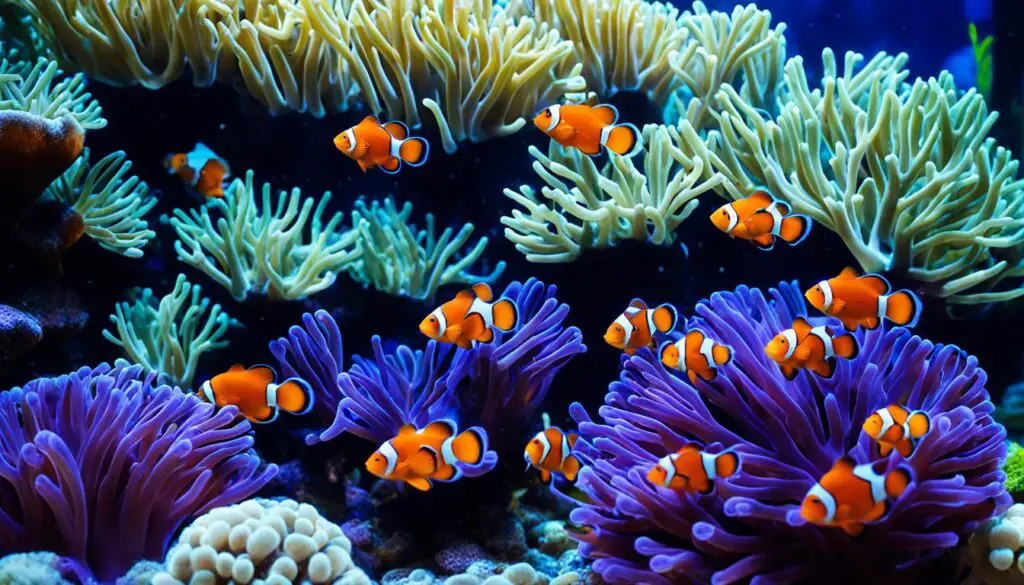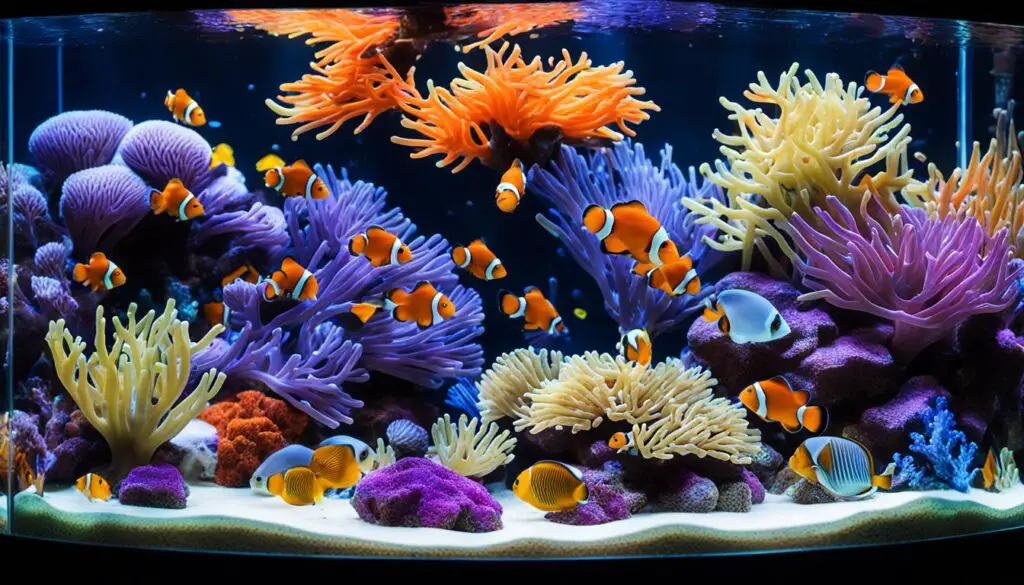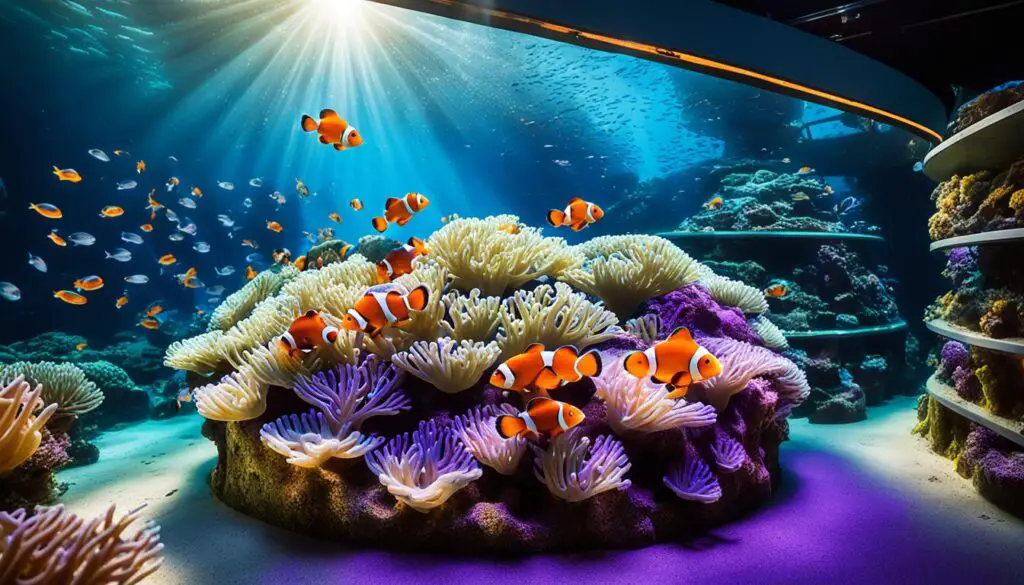Preserving Marine Life: Clownfish Tank Environmental Impact
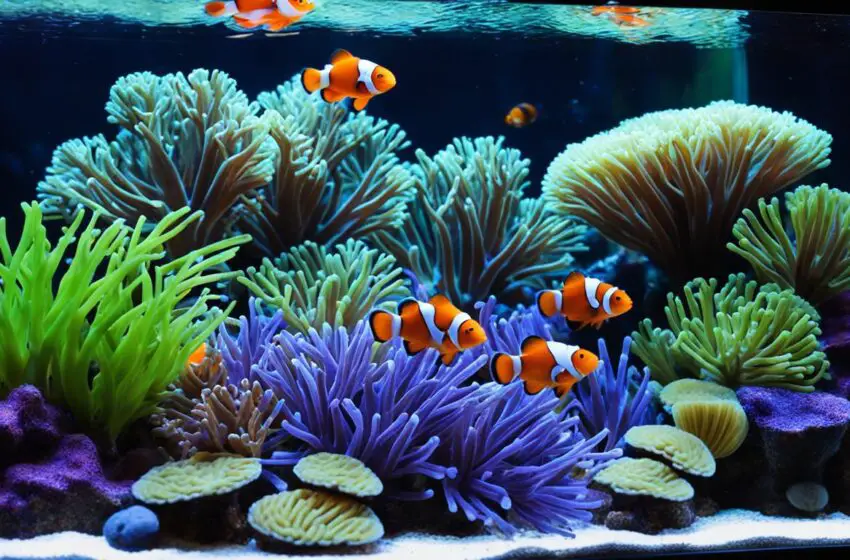
Clownfish are bright, colorful fish loved by many in the tropics. They do well in aquariums at home, making the sea’s beauty part of our daily lives. Yet, the choice to keep them affects the sea and we should be careful about it.
Start by picking Clownfish that were born in tanks, not caught from the ocean. This choice is better for the sea’s health. It cuts down the need to catch them in ways that harm reefs.
Creating a home for Clownfish that feels like their ocean home takes effort. The right filters, lights, and enough room are vital. They lower stress in the fish and help them stay healthy.
Caring for Clownfish the right way is good for both the fish and the sea. Clean tanks prevent bad chemicals and diseases from reaching the ocean. This stops harm to marine life.
We need to balance our love for these fish with the need to protect their home. By caring for them well, we help save marine life and keep coral reefs alive. Our actions are key to a healthier ocean.
Key Takeaways:
- Choosing aquacultured or captive-bred Clownfish helps preserve marine life and reduces environmental impact.
- Proper equipment and maintenance are crucial for a healthy Clownfish tank and the well-being of the fish.
- Sustainable Clownfish tank care contributes to marine life preservation and the protection of coral reef systems.
- Responsible aquarium keeping ensures that harmful chemicals and diseases are not released into the environment.
- By adopting sustainable practices, we can enjoy the beauty of Clownfish while safeguarding their natural habitat.
The Environmental Impact of Clownfish Harvesting
The sale of marine life for home aquariums does more harm than good. For example, Clownfish can cause serious damage to natural coral reefs. They are often caught using bad fishing methods and cyanide.
This has a big negative effect on our underwater world. For instance, when fishermen catch Clownfish, they also kill the reefs around them. They might use explosives to fish or poison the water.
But the damage doesn’t stop there. When harvested Clownfish are let go in new places, they can bring in new species. This can mess up the whole ecosystem of the sea. It makes life hard for other animals who live there.
We must make the rules stricter. We must stop the bad ways of fishing. And we need to tell people about better, safer ways. This will help keep our coral reefs healthy and save our sea friends.
We can all help make things better. A good way is to choose fish that are not taken from the wild. For example, we can support breeding these fish in safe, controlled places. This way, we can have pretty fish to watch without hurting the sea.
If you have a fish tank at home, you can do your part. Keep your water clean and the right temperature. Also, choose products and fish that are good for the ocean. This helps keep the waters and the fish in them healthy.
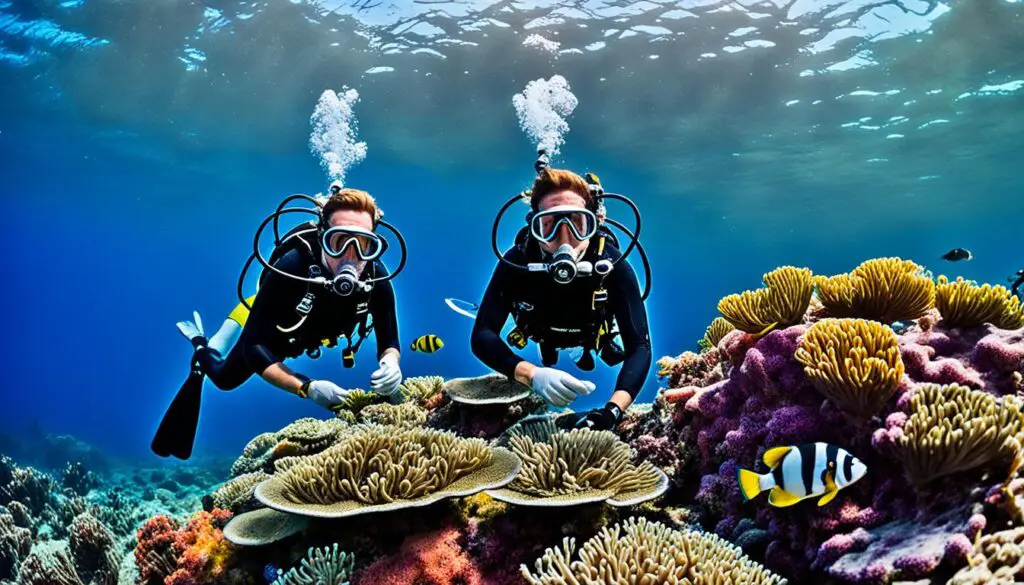
Environmental Impacts of Clownfish Harvesting
| Environmental Impact | Description |
|---|---|
| Reef Destruction | Unsustainable Clownfish harvesting methods physically damage coral reefs. |
| Endangerment of Species | Harvesting practices contribute to the endangerment of various marine species, including Clownfish. |
| Invasive Species Introduction | Escaped or released harvested Clownfish can become invasive species, disrupting native ecosystems. |
Sustainable Practices for Clownfish Tank Care
Being a good aquarium keeper involves choosing the right practices for Clownfish care. It’s very important to pick aquacultured or captive-bred Clownfish. These choices are better for the fish and for the world’s oceans. This way, I help marine life and keep our waters safe.
Creating a home for Clownfish means paying close attention and using the best tools. Keeping the tank clean and healthy is key. I check the water often, change it regularly, and ensure the conditions are just right. By doing these things, my tank is a good place for my fish and helps keep the sea healthy.
But caring for the aquarium is more than just daily routines. It’s also about learning new, better ways. Talking to experts and joining with groups can teach me a lot. This knowledge helps me take even better care of my fish and supports the ocean’s well-being. It’s all about constantly learning and acting for a better environment.
FAQ
What are some sustainable practices for Clownfish tank care?
For a sustainable Clownfish tank, choose aquacultured or captive-bred fish. Make sure your marine aquarium has the right equipment. Keep the water clean and at the right temperature. Do regular water changes. Always check the water’s salinity, temperature, and pH levels. These steps help save marine life and protect coral reefs.
How does the trade of Clownfish impact the environment?
Trading Clownfish harms sensitive coral reefs. It involves bad practices like using cyanide, hurting corals, and fishing unsustainably. These methods cause damage to the reefs, put species at risk, and introduce harmful species to new places.
Why is it important to choose aquacultured or captive-bred Clownfish?
It’s vital to pick aquacultured or captive-bred Clownfish. They are healthier and don’t harm the wild. Choosing these fish supports saving marine life and the environment.
What equipment is needed to set up a marine aquarium for Clownfish?
To create the right home for Clownfish, you need a roomy tank and certain tools. You’ll need a filter, a heater, and a protein skimmer. Plus, you should have proper lighting and natural elements like live rock. This setup ensures your Clownfish live well.
How can I maintain water quality in a Clownfish tank?
To keep your Clownfish healthy and happy, stay on top of the water’s quality. Clean the tank regularly to get rid of waste. Test the water for key measures like temperature, salinity, and pH. Use the right filters to purify the water. A clean and stable environment is crucial for your fish’s well-being.

